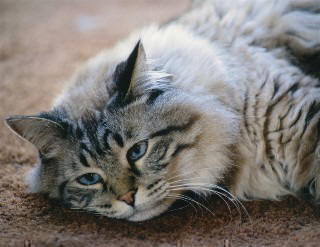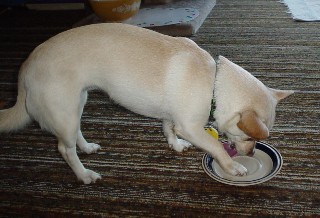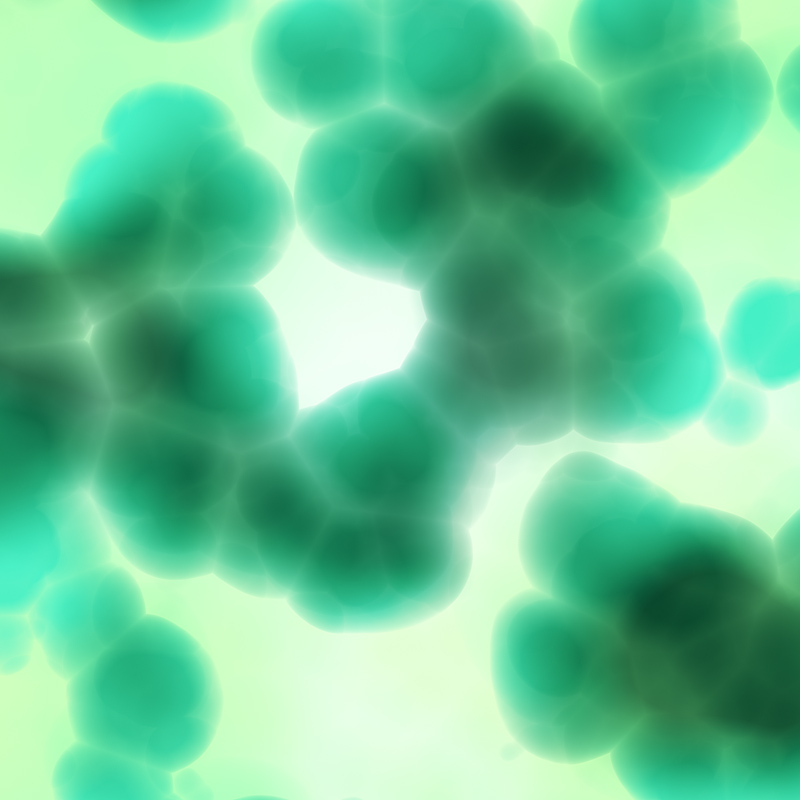Since most domesticated pets are fed processed food and chlorinated
tap water, they probably have lost their natural taste for algae (see
Algae are Nature’s Unique
Superfood at the end). Here are suggestions for getting picky
cats and finicky dogs to accept microalgae products in their food:
- Extremely gradual method: open up a capsule and dip the end of a flat toothpick into the
long end of the capsule. Pull out whatever microalgae powder sticks to
the end of the toothpick (not heaping on the end of the
 toothpick) and mix that into your pet’s food. Do this every time you
feed a meal or fill the dry kibble container. After about 3-5 days,
and every 3-5 days thereafter, mix in an additional toothpick full.
Eventually you will be able to dump ¼-capsule on top of the food
and just mix it up with a spoon. Use this toothpick method for dry
kibble, canned or raw food.
toothpick) and mix that into your pet’s food. Do this every time you
feed a meal or fill the dry kibble container. After about 3-5 days,
and every 3-5 days thereafter, mix in an additional toothpick full.
Eventually you will be able to dump ¼-capsule on top of the food
and just mix it up with a spoon. Use this toothpick method for dry
kibble, canned or raw food.
-
Gradual method: start with just a pinch of powder
(see step #3 in Tips
for Using Partial Capsules below) per meal and hold that amount for 3-5 days. If this amount is
accepted, then increase to two pinches per meal every 3-5 days
thereafter. You can mix the powder into any wet food in two ways:
a. Drop several small dots of powder on the food. Now cover up the
dots (without mixing) with more wet food.
b. Some pets like the powder mixed thoroughly in their food so that
the mixture is homogeneous and they cannot see or smell anything
foreign in their food.
Using this second method
may only get ¼-capsule per day into your pet but that is better
than nothing. One has to give whatever the individual pet will
accept.
-
Try encapsulating the powder in ground
meat, soft bread, cheese, cottage cheese or any soft food.
- Some people have mixed the microalgae powder in softened butter or
milk.
- Most cats love the fishy odor and taste of another whole food
product called Seacure which is
pre-digested whitefish. Mix the microalgae
 powder with the Seacure powder.
powder with the Seacure powder.
- Pet stores now carry a product called
Pill Pockets that you can put a capsule in. We do not know
how successful the cat version is but you can contact the company
and find out (size of pill pocket and success rate with cats). We
are not crazy about the wheat and corn in this product but the small
amount might be insignificant compared to the health value of the
algae.
- One can buy #3 or #4 size smaller capsules and transfer the
microalgae (coming in #1 size capsules) into these smaller ones for
pilling.
- Mix just enough water to make a paste with the
microalgae powder and
smear it with a finger in the pet’s mouth.
- Literally dump the microalgae powder from an open capsule into their
mouth.
- If all the above fails, one can always mix the
microalgae powder in
water and squirt it with a syringe or eye dropper several times per
day. But this is the most intrusive and least desirable
method.
Remember, for optimum results, it is best to
spread the total daily amount of powder equally over the entire day. For
example, for one capsule per day give ½-capsule in the morning and
½-capsule at night. For even better results, feed four ¼-capsule amounts
per day.
We do not suggest pre-mixing the bio-algae
concentrates in any liquid before use. As soon as any liquid touches the
microalgae it starts to oxidize and lose its potency. It is best
consumed immediately if wet. While storing in the refrigerator will
prevent other organisms from growing it will only slow down this
oxidation process not stop it.
Bio-algae concentrates do not have to be
refrigerated due to its superior freeze-drying technology. Do not store
bio-algae concentrates near any heat source (for example, stove, oven,
and heat vent), microwave oven, computer monitor, TV, in direct sunlight
or leave in a hot vehicle. Do store bio-algae concentrates products in a
cool, dry environment. In a cabinet next to a sink or above the stove,
is not a good place.
In some cases, the syringe method is absolutely needed. Here is a
testimonial from a vet:
"We
had a cat that came to our hospital that had not eaten in 4 days. All
lab tests and blood work were negative. Further
examination
found
absolutely nothing wrong with
 the cat but it was still dying. At the
suggestion of Russell Louie, owner of Optimum Choices, I gave the owner some bio-algae concentrates and told him to mix it in water and squirt
it into the cat’s mouth. The cat started to eat and drink a little by
the end of the day. By the next day the cat was eating normally and
totally recovered. I never figured out what was wrong with the cat but
the owner was very thankful that the bio-algae concentrates literally
saved his cat’s life." the cat but it was still dying. At the
suggestion of Russell Louie, owner of Optimum Choices, I gave the owner some bio-algae concentrates and told him to mix it in water and squirt
it into the cat’s mouth. The cat started to eat and drink a little by
the end of the day. By the next day the cat was eating normally and
totally recovered. I never figured out what was wrong with the cat but
the owner was very thankful that the bio-algae concentrates literally
saved his cat’s life."
—Dr. Michael King, DVM,
Canyon Animal Hospital
Tips on Using Partial Capsules
Here are some hints on opening up the
capsules to sprinkle the microalgae powder on food:
-
Make sure your
hands are clean and DRY. If the product is in a capsule, twist the
two halves of the capsule to break the heat seal. This means to
twist laterally across the circumference of the capsule, rather than
pull longitudinally the short/long ends apart. This should break the
heat seal of the two halves and make it easier to pull apart the
short/long ends.
-
Now gently
separate the two halves of the capsule by holding the long end at
the bottom and pull the short end of the capsule off the top.
Immediately tip the open end of the short-half up. The
short half will contain approximately ¼-capsule while the long half
will contain ¾-capsule. If you do this over food, any small amount
of powder that comes out will drop on the food, minimizing waste.
-
Now rotate one of
the capsule parts ¼-turn until just a pinch, ¼-capsule, ½-capsule or
whatever amount of powder you want falls onto any wet pet food or cottage cheese, peanut butter,
etc.
-
Gently put the
two halves of the capsule back together. If you look at the line
between the short and long end of the capsule, this marks
approximately ½ capsule full.
-
Store the
partially used capsule in a moisture-proof, air-tight container such
as a baby jar, pill container or small covered dish for later use.
-
If some of the powder sticks to an ‘empty’
capsule at the end of usage, leave the two halves of the capsule
together but leave the whole capsule in a pill container for at
least 24 hours. After 24 hours, open up the two halves of the
capsule and knock together, pointing the open ends downward to
release the remaining powder in the capsule parts.
The above hints are
useful for all finicky pets (especially cats). We have been able to utilize 98+% of the powder in a capsule using the above tips.

The Kingdoms in Nature are:
- Bacteria (sometimes split into two Kingdoms)
- Protista (means the very first)—includes unicellular
(one-celled) and multicellular organisms, including algae, that are
not part of the Fungi, Plant or Animal Kingdoms)
- Fungi
- Plant
- Animal (herbivores, carnivores, omnivores, including human)
Nature is designed such that each Kingdom is dependent on the ones
below it. For example, ruminant animals (cows, sheep, goats, deer) would
not be able to survive without the bacteria in their rumen that digest
plant foods for them. They are actually eating fermented plant foods and
bacteria. Algae are organisms in the Protista Kingdom at the bottom of
the food chain. All beings (herbivores, carnivores, omnivores, including
human) are dependent on plants, fungi, algae and bacteria for
 survival.
Algae are literally a film that coats the Earth, in every natural body
of water and in the soil. Since algae are everywhere in nature, all
fungi, plants, animals and humans are designed to obtain certain
nutrients from algae (which contain over 5,000 individual nutrients).
When algae are lacking in their diet (as in the sanitized modern diet),
their health may suffer from the missing nutrients. Algae are Nature’s
most complete and original whole food for all species and serves as a
universal food for the plant and animal (including human) Kingdoms.
Algae are nature’s vitamin chest. survival.
Algae are literally a film that coats the Earth, in every natural body
of water and in the soil. Since algae are everywhere in nature, all
fungi, plants, animals and humans are designed to obtain certain
nutrients from algae (which contain over 5,000 individual nutrients).
When algae are lacking in their diet (as in the sanitized modern diet),
their health may suffer from the missing nutrients. Algae are Nature’s
most complete and original whole food for all species and serves as a
universal food for the plant and animal (including human) Kingdoms.
Algae are nature’s vitamin chest.
There are some algae nutrients that are particularly beneficial that are
hard to find from any other source. For example, Gamma Linolenic Acid
(GLA) is usually only found in early mother’s milk. GLA stimulates the
newborn’s immune system. So, how do adult animals get GLA if it needs to
stimulate its immune system? GLA is present in seeds of borage, black
currant, and evening primrose but how many animals (and humans) eat
those foods on a regular basis? The next largest whole food source (not
supplements) of GLA to mother’s milk is algae. There is no other food
that can nourish plants, herbivores, carnivores and omnivores like
algae. Algae occupy a unique role in the food chain for all plants,
animals and humans. No other food (and certainly supplement) can make
this claim. Algae are not just “pond scum.” By feeding
bio-algae concentrates, one
is literally giving super nutrition back to your pet that Nature
intended them to get in the wild.
|
